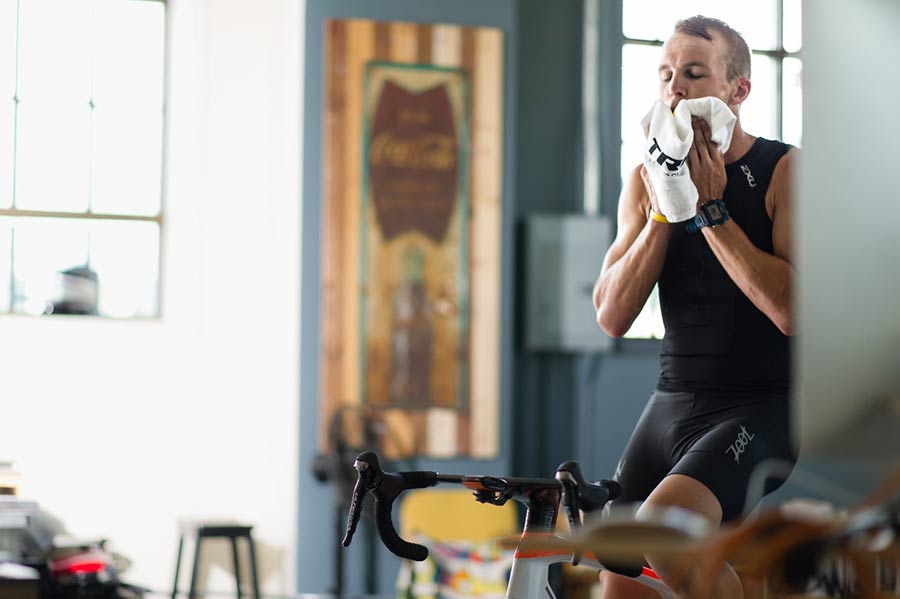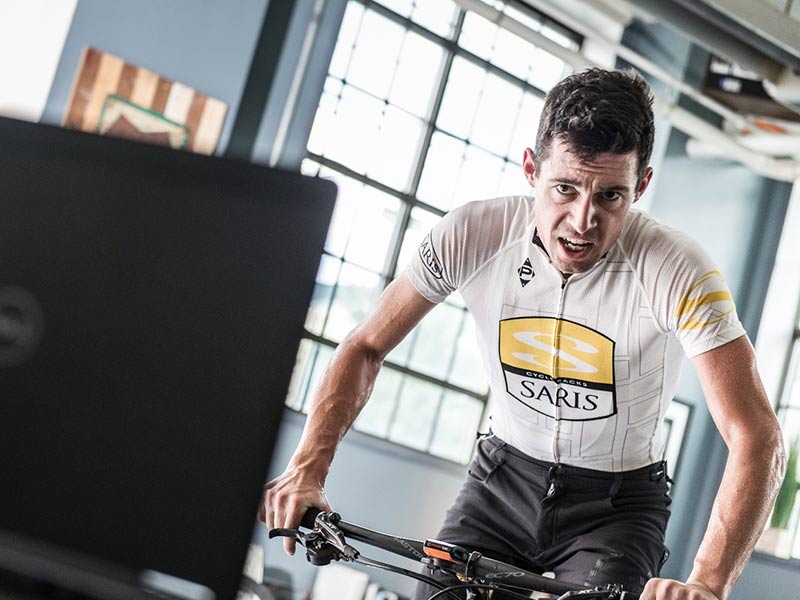By Bob Seebohar, MS, RD, CSSD, CSCS, METS II
For many cyclists, 'tis the season to move workouts inside on the trainer. We all are aware of the convenience, environmental conditions, and safety differences of riding inside versus outside but this article will specifically highlight the nutritional differences between saddling-up outside versus inside.
When it comes to the major nutritional differences, there are really only two main messages: energy expenditure and hydration.

Energy Expenditure
It has been argued that there is a difference in energy expenditure between outside and inside riding. Terrain will be different. Outside there will be wind, heat, cold, cars, stoplights, and other hazards. There is potential to go hard or easy depending on many variables. Inside there will be a controlled environment with the potential to go hard or easy depending on the workout. There may be more similarities than not when comparing the two. In fact, the calories that are burned while cycling are similar, in physiological terms, between riding inside versus outside.
What is important to understand is that energy expenditure is dictated by a cyclist’s body weight, and the duration and intensity of a ride.
In exercise physiology, there is an energy expenditure grading system, if you will, termed the Metabolic Equivalent of Task (MET), that dates back over 25 years ago. MET is a physiological measure detailing the energy cost of a physical activity and ranges from 0.9 (sleeping) to 23 (running at a very fast pace). It is a means of expressing the intensity and energy expenditure of an activity in a way that can compare individuals of different weight.
For example, according to the MET chart, a cyclist weighing 80 kilograms (176 pounds) cycling at 150 watts expends 7.5 calories per minute. If he rides for one hour, he would burn 450 calories. If this same cyclist rides for one hour at 200 watts, he would burn 576 calories. Same body weight and duration but different intensity. That is the beauty of the MET scale. It allows accurate comparison.
Back to riding indoors versus outdoors. What matters the most is the duration and intensity for a specific ride. Is it a recovery ride? Interval day? Tough spin class? What is your intensity factor (IF) afterwards? Many athletes argue that riding inside will burn more calories than riding outside, or vice versa, but it is important to take it at face value and explore the intensity of the ride itself.
Back to nutrition: the take-away message is that no matter if you ride inside or outside, a cyclist will need to consume calories at a certain point during a ride.
As I mentioned before with the MET, the key factors in determining nutrition needs on the bike are the time in saddle and the intensity. In general, it is wise to begin a feeding schedule beginning at 1.5 - 2 hours into a longer, aerobic ride (think zone 1-2). Depending on your state of Metabolic EfficiencyTM, the amount of calories per hour you will need during this ride, will range from 40 - 240.
For rides that are shorter but more intense (intervals, zone 4 and above), a feeding strategy that begins earlier (45-60 minutes into a ride) will likely be necessary.
Remember why this is true? Referring back to my earlier example, a cyclist who rides at a higher intensity will be burning more calories thus will not only need to begin to feed sooner but may also need a higher calorie intake. Pushing the calorie range per hour up a bit to 80 - 360 may be necessary.
Yes, these hourly calorie ranges are large, mostly because it is dependent on the cyclist’s Metabolic Efficiency (ability to use more fat as energy and preserve internal stores of carbohydrate). The more you can tap into your internal fat stores, the more you will preserve your carbohydrate stores and thus will require fewer calories during a ride. The opposite is also true. The more carbohydrates you eat throughout the day, the more you will burn, and the more you will need during a ride.

Hydration
The second main nutrition variable to compare indoor versus outdoor riding is hydration status. There is research that shows the perceived effort riding indoors is higher versus outdoors and it is common to have an increased body core temperature while riding inside. This is due to a lesser skin cooling effect from the wind. You may have a fan pointed at you while riding indoors but if the temperature is still warm in the room, your body will not cool itself as efficiently. This can lead to a greater sweat rate and loss of fluid, which is often the case when riding indoors.
Depending on your training objective for the ride (duration and intensity), you may or may not need more fluid when indoors. There are no specific, individual recommendations about hourly fluid intake while riding indoors versus outdoors because it is dependent upon indoor environmental conditions, and acclimation to heat and sweat rate. If any of the following conditions hold true for a cyclist, more fluids should be consumed per hour:
- Duration exceeding 60 minutes, especially when hitting higher power outputs with interval training
- Little or no air flow from fans or open windows
- Higher normal sweat rate
Learn more about hydration for indoor training.
As you make the decision to ride inside or outside this winter, be sure you keep in mind fueling and hydration strategies as they relate to the environment and your duration and intensity of your ride.

Bob Seebohar, MS, RD, CSSD, CSCS, METS II, is a Sports Dietitian and Endurance Coach.He traveled to the 2008 Olympics as the USA Team Sports Dietitian and the personal Sports Dietitian and Exercise Physiologist for the Olympic Triathlon Team.Currently, he owns eNRG performance, a performance center in Littleton, Colorado that provides sports nutrition services, physiological testing, a training and recovery center and endurance coaching to endurance athletes.
Bob's book, "Metabolic Efficiency Training: Teaching the Body to Burn More Fat" has helped thousands of endurance athletes improve health and performance and has redefined the sports nutrition field.Read more about Bob and eNRG performance at www.enrgperformance.com and contact Bob at bob@enrgperformance.com
